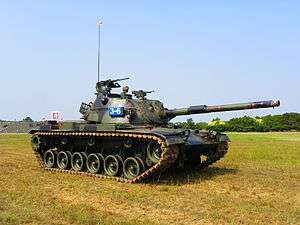CM-11 Brave Tiger
The CM-11 Brave Tiger (Chinese: 勇虎式戰車; pinyin: yǒnghǔshì zhànchē) is a Main Battle Tank (MBT) that was developed by both the American General Dynamics and the Republic of China Army Armored Vehicle Development Center[1] It was introduced to the public on 14 April 1990. Being a variant of the M48 Patton, it is also known as the M48H Main Battle Tank. The CM-11 is a hybrid M60 chassis fitted with the turret from the older M48 Patton and the fire control system of the M1 Abrams.[2]
| CM-11 Brave Tiger M-48H Patton | |
|---|---|
 ROCA CM-11 in Hukou Camp after Exercise | |
| Type | Main Battle Tank |
| Place of origin | |
| Service history | |
| In service | 1990–present |
| Production history | |
| Designer | Republic of China Armored Vehicle Development Center |
| Designed | 1984 |
| Manufacturer | Republic of China Armored Vehicle Development Center |
| No. built | 450 |
| Specifications | |
| Mass | 50 tonnes (55 short tons; 49 long tons) |
| Length | 6.95 meters (22 ft 10 in) (hull) 9.30 meters (30 ft 6 in) (cannon forward) |
| Width | 3.63 meters (11 ft 11 in) |
| Height | 3.09 meters (10 ft 2 in) |
| Crew | 4 |
Main armament | 105 mm (4.1 in) M68 gun |
Secondary armament | .50 BMG (12.7×99mm) M2 Browning 7.62×51mm NATO M240 machine gun |
| Engine | Continental AVDS-1790-2C air-cooled Twin-turbo diesel engine 750 hp (560 kW) |
| Power/weight | 15 hp/t |
| Suspension | Torsion bar suspension |
Operational range | 480 kilometers (300 mi) |
| Maximum speed | 48 km/h |
Development History
The Republic of China (Taiwan) established the Armored Vehicle Development Center in 1980, and was tasked to develop military armored vehicles, and had cooperated with General Dynamics to develop the CM-11.[3] The development of the tank has two main purposes, first was to avoid the limitations set by the US-PRC Joint Communique (17 August Communique), and second was to allow the ROCA to acquire Second Generation MBTs.
The CM-11 is a hybrid tank using the M48A3 turret with the M60A3 tank hull, combined with the new M1 Abrams tank's Fire-Control System (FCS). The United States designated it as M48H, where the "H" means Hybrid, and the Republic of China designated it CM-11 and named it Brave Tiger.
Design
In 1988, two prototype CM-11s were finished and 450 CM-11 were ordered to built. The M60A3 hull was procured from the United States in 1987, and the M48A3 turret and the M68A1 105mm main cannon was produced by the Army Ordnance Maintenance and Development Center. The Commander's turret was procured from Israel with an M2 Browning 12.7mm (.50 caliber) machine gun, the loader operates an M240 7.62mm machine gun, the coaxial machine gun is also an M240. Both sides of the turret have one M239 Smoke Grenade Launcher mounted, like the M60A3 tank.
Advantages
The greatest features and advantages of the CM-11 are that it has the same level of digital/analog hybrid ballistic calculator as the M1A1 Abrams MBT; it has a two-dimensional sighting and gun stabilization system, more complete than the M60A3's one-dimensional stabilizing device; combining the AN/VSG-2 Thermal imager, AN/VVS-2 Image Intensifier, AN/GVS-5 Nd-YAG Laser rangefinder, allowing the CM-11 to have Fire-on-the-Move and Night Combat capabilities. It also has the highest probability of first round hit compared to all other ROCA tanks.
Disadvantages
Disadvantages of the CM-11 are its outdated design, armor, and gun. The Chinese PLA's second-generation Type 96G tank and its third-generation Type 99 tank are both armed with a 125mm main cannon. The CM-11's armor does not offer significant protection against their 125mm APFSDS and HEAT shots. The ROCA knew this disadvantage very early, and tried to introduce explosive reactive armor (ERA) from the French company GIAT. However, the weight of the additional ERA installations caused excessive stress on the M60 chassis's torsion bar suspension, so plans to install ERA on the tanks was put on hold until a solution was found. The CM-11's 750 hp (560 kW) Continental AVDS-1790-2 V12, air-cooled twin-turbo diesel engine is 50-year-old technology as well, having been introduced in February 1963 with the first 600 U.S. Army converted M48A3s.
During the Spring Festival in 2012, the ROCA's 542 Armor Brigade of 6th Army Corps initiated their combat readiness drill, and showed a CM-11 installed with the ERA for the first time. Developed by CSIST, angling was applied to the ERA design to increase deflection probability of incoming shots and reduce the probability of penetrating the hull, which would cause damage to the tank's internal modules and wound the crew inside.
 CM-11 side view
CM-11 side view Rear view of CM-11
Rear view of CM-11
Upgrade Program
In 2017, Taiwan's Ministry of National Defence started new tank upgrade program for which it allocated 6.5 million USD to state-owned National Chung-Shan Institute of Science and Technology for research and development of upgrade package for 450 M60A3 TTS which begins in 2018, testing and evaluation is expected to be complete in 2019 with upgrade program being launched in 2020 from which after completion CM-11 tanks are set to be upgraded next.[2]
See also
References
- The Armored Vehicle Development Center is later called Army Ordnance Maintenance and Development Center, or OMDC for short.
- "Giving up on Abrams tank acquisition, Taiwan moves to upgrade its M60A3 tanks". DefenseNews. 6 October 2017.
- Global Defense Magazine Vol. 70, June 1990
| Wikimedia Commons has media related to CM-11 Brave Tiger. |
_Logo.svg.png)